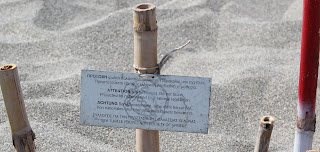Wednesday 31 July 2013
We have spent a few days driving around Mani
- the middle peninsula of the Peloponnese and the second most southerly point
in mainland Europe (after Tarifa in Spain). We’re not sure what to make of it
really. It is quite barren and isolated in parts and we didn’t find the
same welcome we have found in most other areas of Greece.
 |
| Gytheio - gateway to Mani from the east |
 |
| Limenas beach with barren backdrop |
 |
| Sunrise on the hillside near Kotronas |
Famous for its tower houses, Frankish
castles, Byzantine churches and fortified dwellings the architecture is quite
distinct to this area, but sadly many of the houses are abandoned and derelict.
 |
| Tall tower houses - tiny villages |
 |
| Just one of many derelict and abandoned houses |
The scenery is certainly stunning.
Along the spine of the peninsula runs the Taygetos mountain range and until the
70’s when the new roads were built some villages were only accessible by sea. Most
of the narrow winding roads hug the coastline or follow the valleys and gorges
and there has been little investment in signposting. A few nights before we
even arrived at Mani I had a dream that I took a ‘short-cut’ and drove straight
down a mountainside track rather than take the normal zig-zag route. Thankfully
Dave stuck to the main road and we survived the trip – albeit with a few scary
moments!
 |
| Looking south towards the headland |
 |
| Single lane - for miles, with steep drops and no Armco in sight! |
Arriving at the most southerly point of
Inner Mani we watched the large shipping containers rounding the headland. There was a weird sanctuary
which Gareth and I went to investigate. Inside was an odd collection of
offerings from todays ‘pilgrims’ – broken flippers, coins, packets of condoms, toys, jewellery, cigarettes,
pebbles and shells together with a book full of multi-lingual messages. Quite a
contrast to the beautiful votive offerings of carved models, miniature vases and weapons left
in ancient times that we have seen on display in museums on our trip through
Greece.
 |
| Today's offerings to the Oracle! |


The area has a long and chequered
history. Neolithic remains were found in coastal caves and artifacts from the Mycenaean
period (1900 BC - 1100 BC) have been found here. It was occupied by Dorians in
1200 BC and became a dependency of Sparta. Over the subsequent centuries, the peninsula
was fought over by the Byzantines, the Franks (Italian and French knights), and
the Saracens. In 1460, after the fall of Constantinople, local chiefs, wanting
to retain their own internal self-government in Mani, arranged to pay an an
annual tribute to the Ottomans – although it is reported they actually only paid it
once! Even after the Greek War of Independence they wanted to retain local
autonomy and violently resisted outside interference. Ultimately the area
became a backwater and many locals moved to the cities or abroad in search of a
better lifestyle. They certainly came across to us as a feisty bunch! A guy ‘parked’ his car in the middle of the small road
running through Gerolimenas, and staggered into the mini-market. He returned about
5 minutes later with a can of beer in one hand, cigarette in another and swore
at all the, now very impatient, drivers stuck behind him.
 |
| Main road through Gerolimenas - gridlocked! |
Apparently the name Mani originates
from the Greek word "Manîa" (Μανία), meaning "crazed" or
"wild" and the English word
"mania" is said to have derived from this. In all honesty we weren’t
crazy about Mani but it was an interesting drive out to this remote area of
Greece.











































